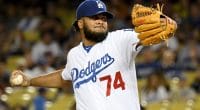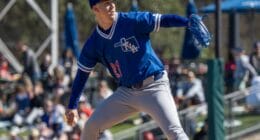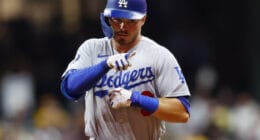It’s the most sorry and tried angle of all-time, but it’s a favorite of haters everywhere: Los Angeles Dodgers ace Clayton Kershaw and his collapse under the pressure of playoffs in October.
But, wait…. This critique is sorry right? It is tried? It can’t be true….right? Right?
With Game 1 against the Washington Nationals in the National League Division Series just a few days away and a matchup between two of the regular season’s best pitchers (No. 1 and No. 4 in WAR according to Fangraphs), let’s look at Kershaw’s history in the playoffs and see for ourselves.
For the sake of relevance, let’s focus our time on the last three seasons and not his performance in 2008 and 2009. In 2008, Kershaw appeared in two games and didn’t start either, while in 2009, he was so inexperienced his regular-season ERA was a bloated 2.79.
In the last three postseasons, Kershaw has started eight games and has allowed 23 earned runs over 49.1 IP, for an ERA of 4.20. Over that stretch he has allowed 37 hits, 14 walks and recorded 66 strikeouts.
On the surface, none of that (aside from the ridiculous strikeout numbers) is very good. Every single one of those would be above Kershaw’s regular-season averages in the past four seasons. So, what’s the deal?
Honestly, it starts with luck.
In those eight starts, 45 percent of hitters who have reached base against Kershaw have scored. To be honest, I initially wasn’t certain how that compared to his career number. After digging deeper, I unearthed just 28 percent of those who reached base on Kershaw in his career, score.
Think about that.
That’s compared to the average of all teams this season, which is 36.3 percent of baserunners went on to score. Last season it was 35.1 percent.
If 28 percent of baserunners scored against Kershaw in the playoffs, his ERA would drop to 2.61. For comparison’s sake: Madison Bumgarner has seen just 26 percent of baserunners score against him in the playoffs, down from a career 33 percent.
If both left-handers simply pitched to their career averages, Kershaw would actually have a better ERA than Bumgarner in the postseason (2.78).
Now, this is hypothetical, but somewhere in there, there’s probably something interesting as well. The second thing to consider is the small sample size we’re dealing with.
In those eight starts, Kershaw has six games with less than three runs allowed and two games with more than three runs allowed. Here is his list of earned runs allowed in each start: one, zero, zero, seven, eight, three, three, one.
Which two don’t look like the others?
The reality is, you could pitch six perfect games and throw those two middle outcomes into the equation and the ERA will still look bloated (as it should). So what happened on Oct. 18, 2013 and Oct. 3, 2014?
Let’s start with 2013 — Game 6 of the NL Championship Series in St. Louis.
Simply put, it was a rough outing. Kershaw left the game in the fifth trailing, 5-0, and with two runners on and nobody out. Ronald Bellisario and J.P. Howell allowed both runners to score before getting out of the inning, and that was that.
Kershaw’s final line that night: four innings pitched, 10 hits, two walks, five strikeouts, seven earned runs allowed. And he deserved blame for every inch of that poor start. Even the best in the world have off days.
The NLDS game on Oct. 3, 2014, however, is a different story. Over 6.2 innings, Kershaw allowed eight hitters to reach base (all via hit) and struck out 10 (exactly half of the outs he recorded).
All eight baserunners came around to score against him.
Is that bad luck? Is it bad pitching? An argument could be made for both, but either way it’s impossible to read that and not think there’s some bad luck involved. Just as you can’t blame all eight runs on bad luck.
In that outing, Kershaw allowed a home run to Randal Grichuk in the first inning before retiring 16 consecutive batters. The next hit was yet another home run — this time from Matt Carpenter in the sixth.
Then came the seventh. Dodgers were leading, 6-2, and Kershaw was at 81 pitches when he took the mound for what would become the worst 30 minutes of his career.
Single, single, single, single, strikeout, single, strikeout, double.
The ball was put into play six times, and all six times it found an unoccupied plot of land to plant itself. Twice in this stretch Kershaw was ahead 0-2 on a batter that would eventually get a hit.
But it didn’t matter, because now down 7-6, Kershaw’s night was done. In came Pedro Baez, who promptly walked the first batter he saw before giving up a three-run homer to Matt Holliday.
Did the Dodgers wait too long to pull Kershaw? Was the shotty bullpen the reason? Was it just a batter of BABIP (batting average on balls in play) bad luck? Who knows.
The reality is, Kershaw allowed eight earned runs for just the third time in his career and he had allowed eight or less runs total in each of the final four months of that season.
Sometimes, baseball is just weird.
In 263 career starts, Kershaw has the best ERA and WHIP in baseball history. He led the league in ERA in 2011, 2012, 2013 and 2014, and would have again this year had he pitched 13 more innings. Kershaw has won the Cy Young three times and also has an MVP to his name.
None of this is news to anyone, but the fact that we’re going to assume that because of two bad starts in the playoffs that Kershaw is anything less than the most feared pitcher in baseball come the postseason is ridiculous.
Clayton Kershaw is the best pitcher in baseball — and that won’t change just because the calendar has turned.





